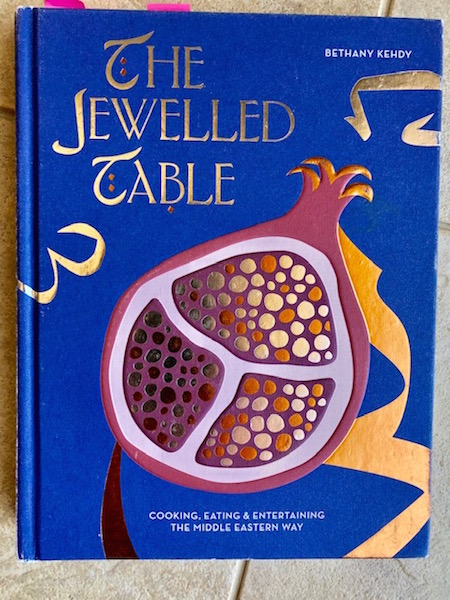The Jewelled Table by Bethany Kehdy
July 3, 2019 • Category: Reviews

ut class="jpibfi" type="hidden">


The Jewelled Table by Bethany Kehdy
Joumana Accad Mediterranean, Middle Eastern July 3, 2019 Reviews, Cookbook review, tagged,Ingredients
This cookbook by Bethany Kehdy is much more than a recipe book with beautiful images and layout; it is an enjoyable read for its sharp wit and the creativity displayed throughout the pages. Her prose is impeccable and offers a rich store of pointed facts delving into the historical origin of food from the region. Kehdy’s world is wide in its scope, and in that book she takes the reader on a whirlwind tour of the greater Middle East encompassing the Mediterranean and Central Asia; thus, her recipes are inspired by Greek, Moroccan, Iranian, Yemeni, Gulf, Lebanese, Syrian, Palestinian, Egyptian culinary cultures. The layout of her book is just lovely, with a graphic design that reminds of the Finnish style of Marimekko, interspersed with beautiful styled food photographs, and shots of Lebanese scenery, people, and some urban shots with a “reality documentary feel” .
The reader gets dazzled by her brainy writing. Each introduction is impressively well-documented, showing encyclopedic knowledge of the topic at hand, with references to medieval Arab writers and many explanations of the etymological roots of names of dishes. In her recipes, however, Kehdy is not bound by tradition, quite the opposite! She loves to come-up with her own inventive version of classics as well as create new vocabulary for her concoctions: Béchamel sauce becomes "Kishkamel"(using kishk instead of milk and flour); Arak becomes "Araktini"(spiked with pickling brine); Bloody Mary becomes "Bloody Maryam" (using arak and zaatar).
Her recipes are delightfully creative and her titles are always playful: A section in which she presents fenugreek is entitled “Its all fenugreek to me”. I loved her description of the raw veggie and herb platters commonly presented in the Middle East, “Plated Gardens” and her suggestions on various combos. She devotes a section on salt, aptly titled “Don’t spill the salt”, in which she recounts how crucial salt was to ancient civilisations, deriving so many foods from its usage (pickles, cheese, relish, cured meats, etc) . Some of Kehdy’s ideas are irresistible; I loved her "Tea towel popcorn with kishk" in which she sprinkles kishk on popcorn; her boiled artichoke with green kishk; and the "Kishkamel Moussaka" which I couldn't help testing (with a very satisfactory result).
Kehdy fearlessly takes on all the classics and puts her spin on them: The traditional meat kibbeh pie becomes kibbeh with loquat stuffing, hummus (the chickpea kind) becomes butter hummus, using butter instead of tahini to cream it. The reader enjoys this ride into her kitchen, even if at times, the combinations seem to be a bit of a stretch. (like the coconut tarator sauce or the raw beetroot tartare knuckles).
This book is a treasure: it is beautiful, and clever, and inspiring, and informative. It is liberating if you are still intimidated while making classics. By following Kehdy’s lead, the sky is the limit in one’s kitchen!
Instructions


Hello! All photos and content are copyright protected. Please do not use our photos without prior written permission. If you wish to republish this recipe, please rewrite the recipe in your own unique words and link back to the source recipe here on tasteofbeirut.com. Thank you!
